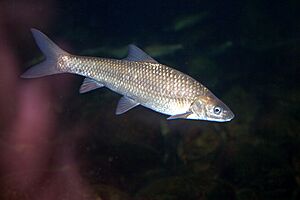Cape whitefish facts for kids
Quick facts for kids Cape whitefish |
|
|---|---|
 |
|
| Conservation status | |
| Scientific classification | |
| Synonyms | |
|
The Cape whitefish is a special type of fish. It is also called the Berg-breede River whitefish. Its scientific name is Cheilobarbus capensis. This fish belongs to the Cyprinidae family. This family includes many ray-finned fish species. The Cape whitefish used to be grouped with other South African fish called redfins. Its closest relative is another fish called the sawfin.
Contents
Where the Cape Whitefish Lives
The Cape whitefish is a unique fish. It is found only in the Western Cape Province of South Africa. This means it is endemic to that area. You can find it in the Breede River. It lives in places like the Brandvlei Dam and Sanddrift Dam. It also lives in the Hex River.
Past Homes of the Cape Whitefish
This fish used to live in the Berg River too. Sadly, it seems to have disappeared from there. Some groups of these fish have been moved. They were taken to water areas on farms. We don't know yet if these fish are doing well there.
What the Cape Whitefish Does
Cape whitefish like to live in deeper parts of rivers. They prefer areas with rocky shores. They also like places with trees along the riverbanks.
Young Fish vs. Adult Fish
Young Cape whitefish are often found in fast-moving water. These areas are called riffles. Adult fish, however, prefer slower water. They can live well in calm parts of the river.
What They Eat
Young Cape whitefish are carnivores. They eat tiny water animals called zooplankton. They also eat small aquatic invertebrates. Adult fish have a more varied diet. They are omnivorous. This means they eat both plants and animals. Their diet includes small creatures living on the riverbed. They also eat algae.
How They Reproduce
The Cape whitefish breeds in late spring. This is usually around October. The water needs to be warm, above 20 degrees Celsius (68 degrees Fahrenheit). Adult fish form schools or groups. They travel to shallow, rocky areas to lay their eggs. These areas are usually over one meter deep. They lay their eggs in the late morning hours. A large female can lay about 100,000 eggs! In dams, they use rocky and gravelly spots in shallow water to lay eggs. These fish can live for a long time.
Why the Cape Whitefish Needs Help
The Cape whitefish is in trouble. It is considered Endangered by the IUCN. This means its numbers have dropped a lot. This has happened in recent years.
Main Threats to the Fish
One big problem is an introduced fish. This is the smallmouth bass (Micropterus dolomieu). It was brought into the area by people. The smallmouth bass eats young Cape whitefish. It has caused many Cape whitefish to disappear from the Berg River watershed.
In Brandvlei Dam, the Cape whitefish population is healthier. But another fish, the African catfish (Clarias gariepinus), is spreading there. We need to find out how this will affect the Cape whitefish.
Other fish are also causing problems. The common carp (Cyprinus carpio) and Mozambique tilapia (Oreochromis mossambicus) were brought in for aquaculture. They compete with the Cape whitefish for food. Water pollution is also a serious issue.
Conservation Efforts
The Cape whitefish is also listed as endangered. This is by the Nature Conservation Ordinance of Western Cape Province. For now, people are not allowed to kill them. They can only be caught for special research. This research involves moving them to new habitats.
There is a plan to help these fish. The goal is to bring their numbers back up. This way, this large fish could be used for fishing. It might even be used for aquaculture. This would be a better choice than using harmful introduced species.
Other Reasons for Decline
Many things have caused the Cape whitefish population to drop. Human activities are one reason. A very bad flood in 2008 also hurt the fish. Other fish that eat them have also invaded their homes.
To help the Cape whitefish, people are working on solutions. They are trying to control the non-native fish. They are also working to reduce the impact of farming on water habitats.


